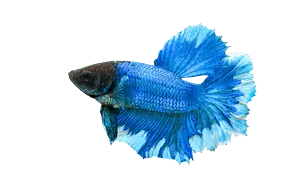There are several benefits to adding plants to your tropical fish aquarium:
- Water oxygenation
- Removal of excess nutrients
- Provision of shade and cover
- Addition of tannins to the water
- Aesthetic appeal
Betta fish, in particular, enjoy tank environments with heavy vegetation. They come from Southeast Asia, where they enjoy sluggish and plant-dense waters.
There’s a wide range of aquarium plants suitable for betta fish tanks. Different plants have variations in color, size, and growth rate.
These are some of the fastest growing aquarium plants for betta keepers. But be careful — some of these will take over your entire tank in no time.
#1 Water Wisteria (Hygrophila difformis)
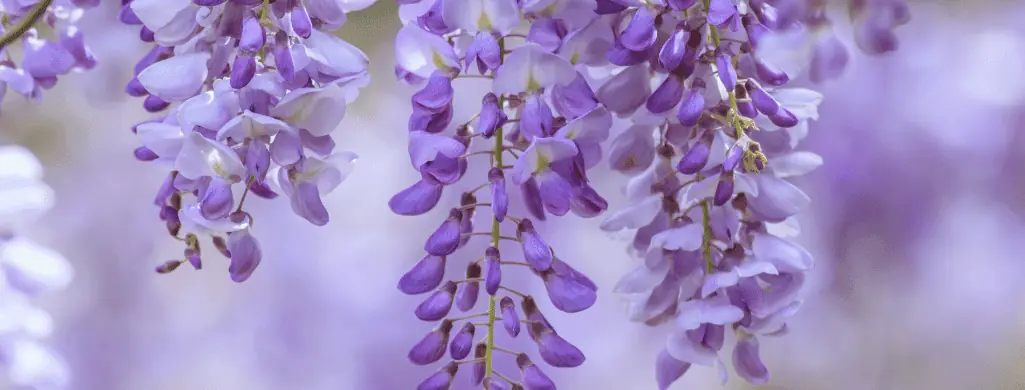
- Care: Easy
- Temperature: 70-82° degrees Fahrenheit (21-27.8°C)
- pH: 6.5 to 7.5
- Minimum tank size: 10 gallons
- Lighting: Moderate to high
- Tank placement: Background, Carpet, Floating
Water wisteria is a popular plant among those in the aquarium hobby.
Not only does this plant grow quickly, but it’s rather easy to care for and boasts beautiful green foliage.
Its leaves are long and thin, and the plant itself can grow up to 20″ inches tall.
Water wisteria is a fast-growing plant, so it’s best for larger aquariums (10+ gallons). If you put it in a too-small aquarium, the plant will outgrow its space in only a short time.
Water wisteria is one of many aquatic plant species which may experience “melting.” Melting is when the plant appears to be failing and loses its leaves after submersion.
But this is a normal process, and the plant will grow leaves better suited to the aquatic environment.
#2 Hornwort (Ceratophyllum demersum)
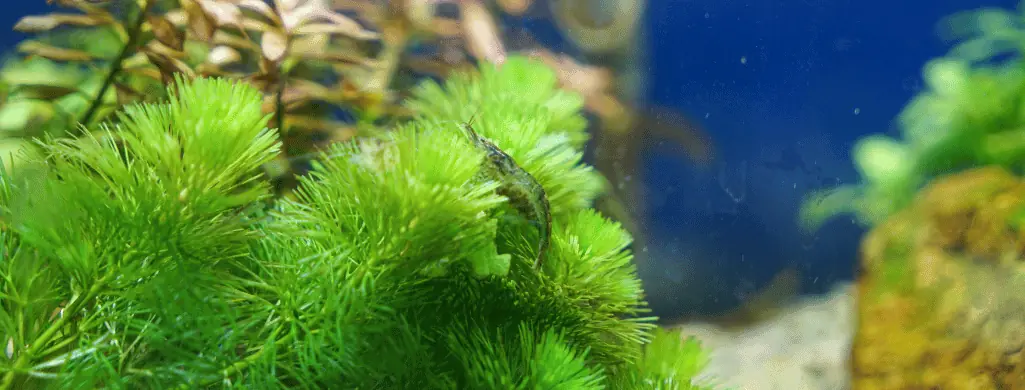
- Care: Easy
- Temperature: 59-86° degrees Fahrenheit (15-30°C)
- pH: 6 to 7.5
- Minimum tank size: 15 gallons
- Lighting: Low to Moderate
- Tank placement: Background, Floating
Hornwort is another undemanding plant well-loved by aquarists.
This plant gains anywhere from 1″ to 4″ inches in height per week. Ensure you trim the plant often to avoid excess growth and related plant health issues.
Hornwort is a hardy plant and perfect for beginners. It thrives in a wide range of temperatures. This means you don’t have to worry as much about monitoring the temperature.
This beautiful plant features green leaves resembling pine needles. It makes for a wonderful background or floating plant.
Hornwort is especially good at consuming excess waste and nutrients. This makes the water more livable for fish and other plants alike.
Learn more about having hornwort in your betta tank here.
#3 Amazon Sword (Echinodorus amazonicus)
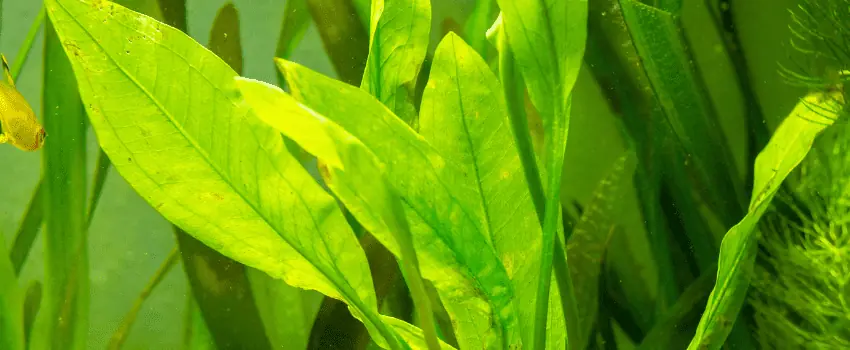
- Care: Easy
- Temperature: 68-82° degrees Fahrenheit (20-27.8°C)
- pH: 6.5 to 7.5
- Minimum tank size: 10 gallons
- Lighting: Moderate
- Tank placement: Background, Mid-ground
Another easy-to-care-for plant, Amazon Sword, has a vibrant green color and lush leaves.
Amazon Sword plants can grow from 12″ to 18″ inches tall, depending on the variety. This makes it necessary to prune the plant often.
Also, it’s essential to have a large enough tank for this plant. A 10-gallon tank is usually large enough, but some aquarists prefer larger tanks of 20 or 30 gallons.
Anything smaller than 10 gallons will have you trimming and pruning your plant a lot.
Amazon Sword is a root plant, meaning you plant it in the substrate. People in the aquarium hobby usually plant it in the background or mid-ground due to its height.
Finally, this plant does best when you perform frequent water changes.
#4 Ludwigia (Ludwigia repens)
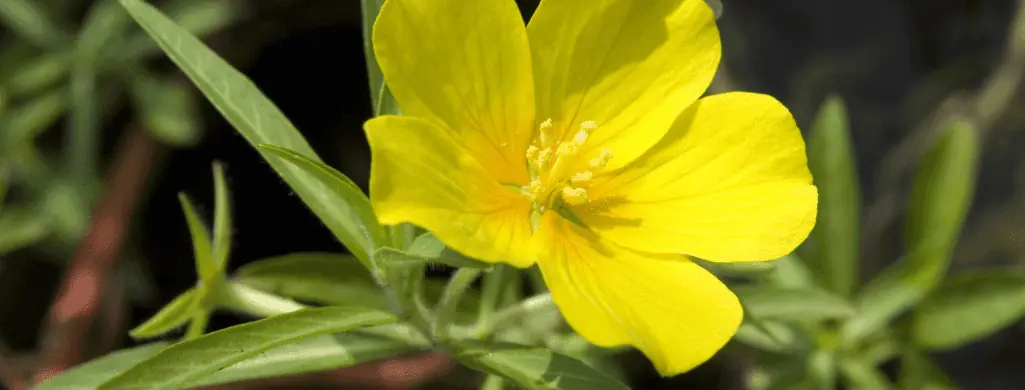
- Care: Easy
- Temperature: 68-82° degrees Fahrenheit (20-27.8°C)
- pH: 6 to 8
- Minimum tank size: 10 to 20 gallons
- Lighting: Moderate to High
- Tank placement: Background, Mid-ground
Ludwigia repens can live in a range of water conditions, making it one of the best plants for beginners. Of course, due to its rapid growth rate, it also needs regular trimming to prevent overgrowth.
Beginner and experienced aquarists alike love the appearance of this plant. Its leaves present an attractive dark or olive green color on top. Its undersides show bits of red.
The leaves can reach 2″ to 3″ inches in width, and the plant can grow up to 20″ inches tall.
Keep in mind: for the best red color, Ludwigia repens needs moderate to high lighting.
Also, you may need to add nutrients to the tank water, as this plant quickly uses them.
#5 Cryptocoryne (Cryptocoryne wendtii)
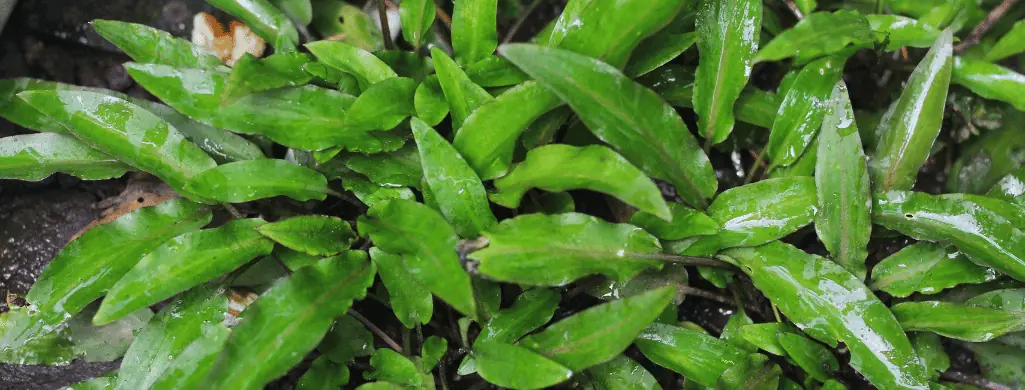
- Care: Beginner
- Temperature: Any
- pH: Any
- Minimum tank size: 5 gallons
- Lighting: Any
- Tank placement: Foreground, Mid-ground, Background
Cryptocoryne wendtii is a very hardy plant, making it an ideal choice for beginners. This plant originates in Sri Lanka and thrives in various water parameters.
It has no special care requirements.
When you first plant Cryptocoryne wendtii in your tank, it might experience melting. After the melting phase, it will grow leaves better suited to the aquatic environment.
This plant comes in a wide range of colors, including various shades of green, red, and brown. It also shows leaf size and texture variations, depending on the exact type.
This beautiful and undemanding plant will look great anywhere in your tank.
#6 Anacharis (Elodea canadensis)
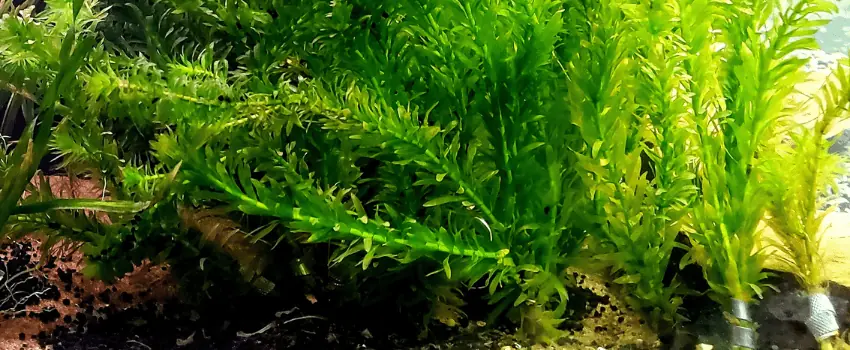
- Care: Easy
- Temperature: 72-78° degrees Fahrenheit (22-26°C)
- pH: 6.5 to 8
- Minimum tank size: 5 gallons
- Lighting: Moderate
- Tank placement: Floating, Background
Anacharis originates in Southeast Brazil, Uruguay, and Argentina. It’s somewhat adaptable to different water conditions.
This being said, it does best in slow-moving waters of neutral acidity.
Healthy anacharis will have a very deep green color. Its root system consists of thin, white roots.
While this is often used as a floating plant, many aquarists love it as a background plant due to its height.
Since anacharis grows so quickly, it’s important to prune and trim it often.
Also, ensure your tank is large enough to support its rapid growth rate. This plant can sometimes grow up to six feet tall!
#7 Rotala (Rotala rotundifolia)
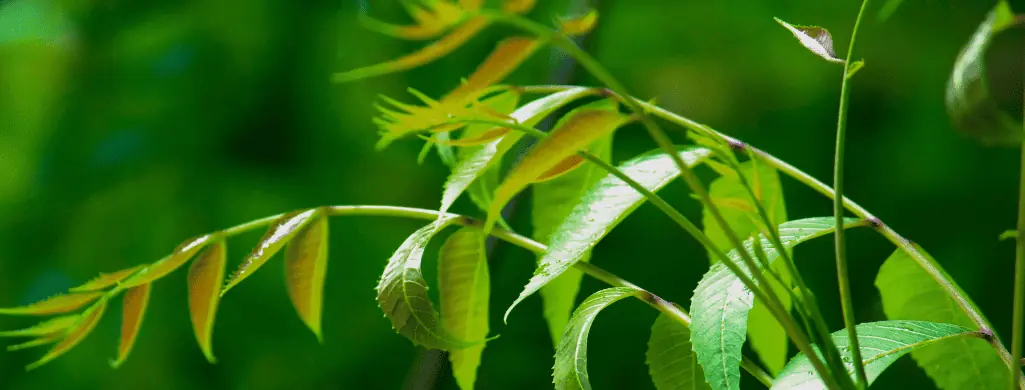
- Care: Easy
- Temperature: 68-82° degrees Fahrenheit (20-27.8°C)
- pH: 6 to 8
- Minimum tank size: 10 gallons
- Lighting: Moderate
- Tank placement: Mid-ground, Background
Rotala is an impressive aquarium plant with vibrant red coloration and narrow leaves. It originates in Southeast Asia, where it thrives in the sluggish and brackish waters.
While this plant is easy to care for, it needs frequent trimming and pruning due to its rapid growth rate. In some cases, it can grow up to 12″ inches tall.
Rotala’s gorgeous red colors only become prominent under the appropriate lighting conditions. Experts recommend moderate to high light levels for the best results.
Researchers have even studied this plant for its potential to remediate eutrophic waters.
#8 Dwarf Hairgrass (Eleocharis acicularis)
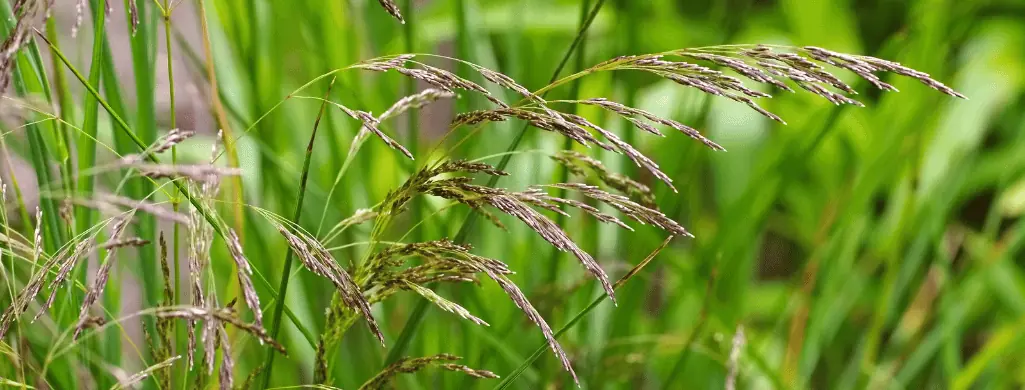
- Care: Moderate
- Temperature: 68-82° degrees Fahrenheit (20-27.8°C)
- pH: 6.5 to 7.5
- Minimum tank size: 10 gallons
- Lighting: Moderate to High
- Tank placement: Foreground (as carpet), Background (as a taller plant)
Dwarf hairgrass resembles grass blades. It’s bright green in color with thin, white roots. It works well as a carpeting plant, but many aquarists grow it tall as a background plant.
This versatile plant is somewhat adaptable and is best for smaller aquariums. It grows from 4″ to 6″ inches tall and needs only occasional pruning and trimming.
Tip: To grow dwarf hairgrass as a carpet plant, give it moderate to high lighting. To grow it as a background plant, give it lower lighting.
#9 Brazilian Pennywort (Hydrocotyle leucocephala)
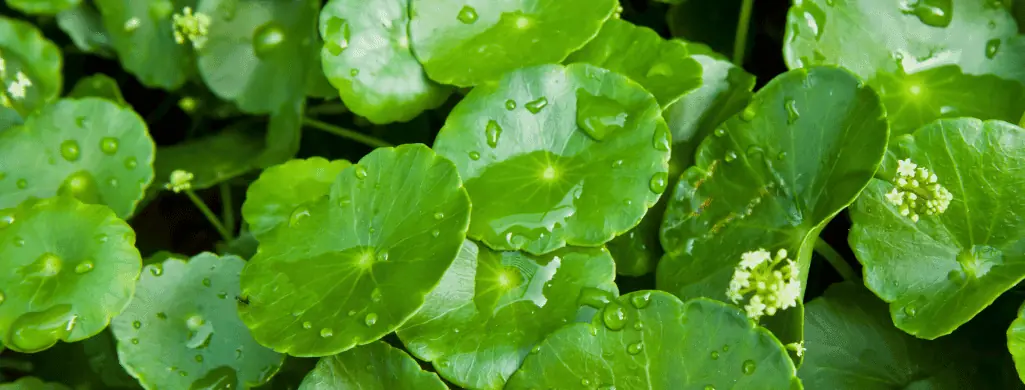
- Care: Easy
- Temperature: 68-82° degrees Fahrenheit (20-27.8°C)
- pH: 6 to 8
- Minimum tank size: 10 gallons
- Lighting: Moderate
- Tank placement: Foreground, Mid-ground, Background, Floating
Brazilian pennywort is another fast-growing and versatile plant for aquariums. It originates in Central and South America, including Brazil, and grows up to 24″ inches tall.
People in the aquarium hobby love this plant for its bright green leaves. These leaves are usually kidney-shaped and grow to be the size of a half-dollar.
This hardy plant does well in a wide range of water conditions.
However, it undergoes melting upon submersion. Once it recovers, the plant does an efficient job of removing nitrates from the water.
Brazilian pennywort needs frequent pruning and trimming to prevent overgrowth.
#10 Vallisneria (Vallisneria spp.)
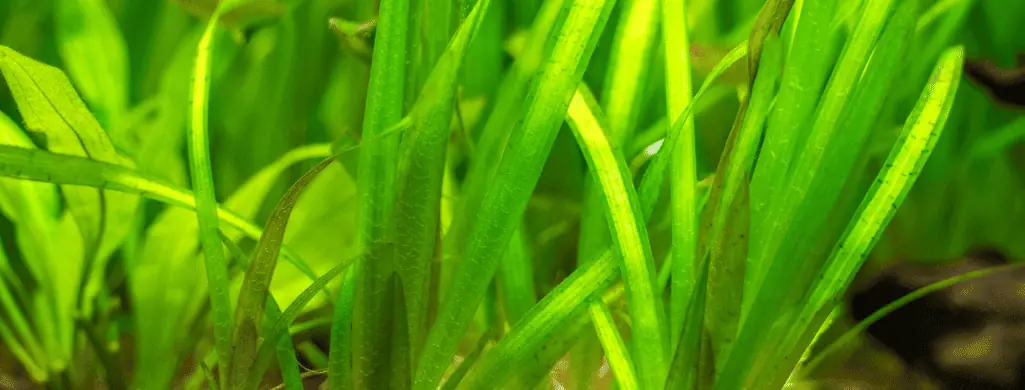
- Care: Easy
- Temperature: 59-86° degrees Fahrenheit (15-30°C)
- pH: 6.5 to 8.5
- Minimum tank size: 10 gallons
- Lighting: Moderate to High
- Tank placement: Background, Mid-ground
Vallisneria, also called Eelgrass or Jungle Val, exists on every continent but Antarctica. Its fast growth rate, vibrant green color, and adaptability make it a favorite in the hobby.
There are a few different varieties of Vallisneria:
- Vallisneria americana
- Vallisneria nana
- Corkscrew Vallisneria
- Vallisneria spiralis
This plant resembles grass in appearance. It looks amazing in the background or mid-ground of any fish tank.
Keep in mind it needs frequent pruning and trimming to prevent overgrowth.
#11 Water Sprite (Ceratopteris thalictroides)
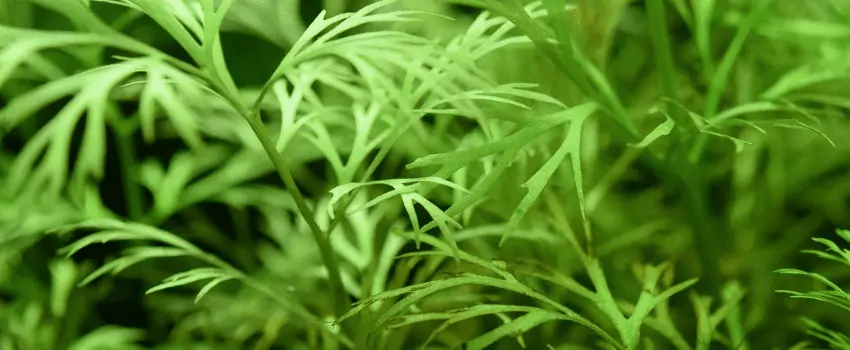
- Care: Easy to Moderate
- Temperature: 68-82° degrees Fahrenheit (20-27.8°C)
- pH: 7 to 7.5
- Minimum tank size: 10 gallons
- Lighting: Moderate
- Tank placement: Background, Mid-ground, Floating
Water Sprite is a beautiful and undemanding plant. It originates in various parts of the world, including the following:
- Northern Australia
- Southeast Asia
- India
- East Africa
- Central America
It features green leaves resembling those of ferns. These fern-like leaves are perfect for providing your fish or other plants with shade.
The leaf appearance will differ depending on whether the plant is floating or rooted.
When floating, the leaves will be broader and stronger. When planted, they will be narrower and less sturdy.
While Water Sprite is adaptable, it needs trimming and pruning due to its fast growth rate.
#12 Green Cabomba (Cabomba caroliniana)
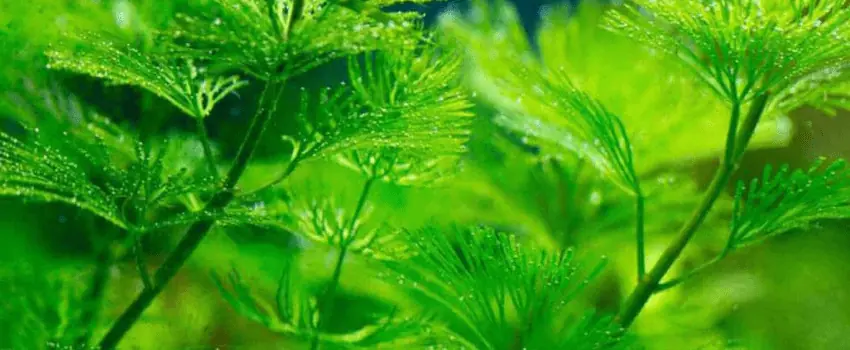
- Care: Moderate
- Temperature: 72-82° degrees Fahrenheit (22-28°C)
- pH: 6 to 7.5
- Minimum tank size: 10 gallons
- Lighting: Moderate to High
- Tank placement: Mid-ground, Background, Floating
Green Cabomba is the most popular Cabomba variety. It grows throughout the Americas and Canada.
This plant boasts a bright green color, with leaves resembling pine needles.
It can thrive in a range of water parameters but needs moderate to high lighting. Under the best conditions, this plant can grow to 20″ inches in height.
Green Cabomba has pretty stringent trimming needs.
It can grow up to 1″ inch per day, so it could quickly outgrow your tank. Also, it sometimes needs extra nutrients added to the soil or water.
People love this plant for its vibrancy and ability to remove excess nutrients. It also helps slow algae growth by consuming it.
#13 Red Ludwigia (Ludwigia glandulosa)
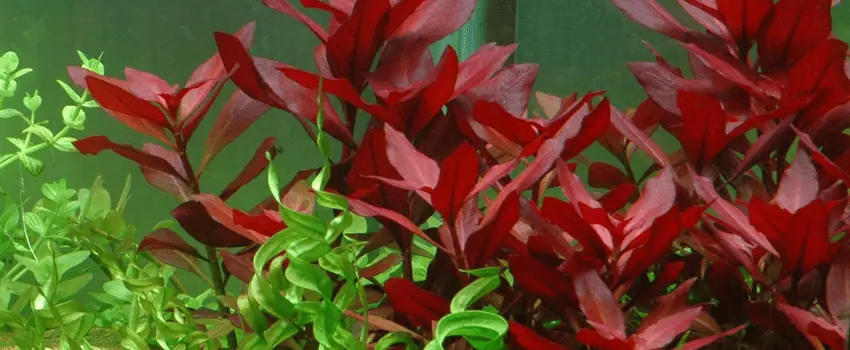
- Care: Easy
- Temperature: 68-82° degrees Fahrenheit (20-27.8°C)
- pH: 6 to 8
- Minimum tank size: 10 to 20 gallons
- Lighting: High
- Tank placement: Mid-ground, Background
Red ludwigia originates in various parts of the world, including the following:
- US
- Mexico
- Central and North America
- Asia
- Africa
- Australia
This plant boasts olive-green leaves with reddish undersides. It also has wide, sturdy, reddish stems. Red ludwigia can grow yellow-petaled flowers, as well, if you let it grow beyond the waterline.
Its rapid growth rate makes it ideal for larger tanks as a mid-ground or background plant. With a max. height of about 20″ inches, red ludwigia needs frequent pruning and trimming.
Finally, while this plant thrives in a range of water parameters, it has heavy nutrition needs. Use a nutrient-rich substrate or add nutrients to it after planting the red ludwigia.
#14 Waterweed (Elodea densa)

- Care: Easy
- Temperature: 50-77° degrees Fahrenheit (10-25°C)
- pH: 6 to 8
- Minimum tank size: 10 gallons
- Lighting: Moderate to High
- Tank placement: Floating
Waterweed is another species of anacharis.
It’s a beautiful floating plant for any aquarium, featuring bright green foliage. It can sometimes grow white flowers at the water’s surface, as well.
Keep in mind: this plant species is invasive in the United States and some other countries. This makes it difficult to come by — or even illegal — in some states.
Be mindful of this while shopping, and opt for a different aquarium plant if this one is illegal in your state.
#15 Duckweed (Lemnaceae)
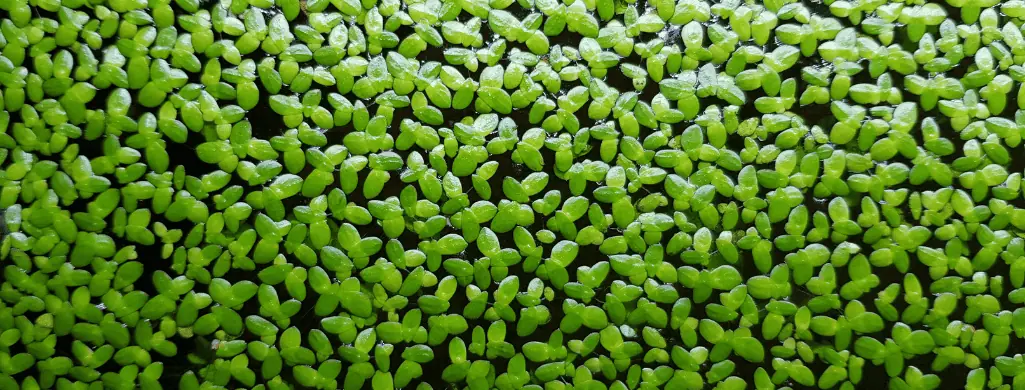
- Care: Easy
- Temperature: 63-79° degrees Fahrenheit (17-26°C)
- pH: 6 to 8
- Minimum tank size: 1 gallon
- Lighting: Moderate to High
- Tank placement: Floating
Duckweed is a gorgeous (and tiny) plant for aquariums. There are five different species of duckweed, and lemnaceae is the most common:
- Lemnaceae
- Spirodela
- Landoltia
- Wolffiella
- Wolffia
Duckweeds are small, green plants that float on the water surface of ponds or aquariums. They have thin roots reaching down into the water for nutrients.
They have a very fast growth rate, making it important to check for and curb overgrowth. Letting it grow too much can deoxygenate the water, hurting your other plants and fish.
Some fish do better in planted tanks than others. Here’s our list of the best fish for planted tanks if you want to see what fish thrive in heavily planted environments.
#16 Amazon Frogbit (Limnobium Laevigatum)
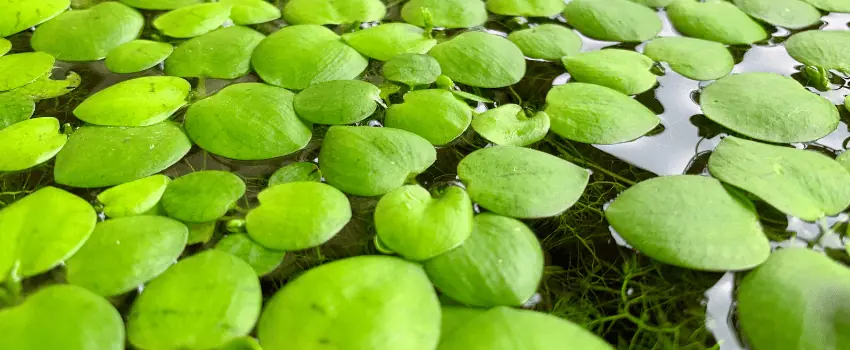
- Care: Easy
- Temperature: 64-86° degrees Fahrenheit (18-30°C)
- pH: 6 to 7.5
- Minimum tank size: 20 gallons
- Lighting: Moderate to High
- Tank placement: Floating
For good reasons, Amazon frogbit is one of the most popular plants among aquarists.
It originates in South and Central America but is invasive in several other places:
- Africa
- Europe
- Australia
Amazon frogbit is similar in appearance to lily pads, and it produces yellow or white flowers. Its pads grow to be about an inch in diameter, and the plant can quickly overgrow its tank.
Unlike other fast-growing aquarium plants, Amazon frogbit does not need trimming or pruning.
Rather, scoop out bunches of the plant and dispose of them safely. This plant is best for larger tanks due to its rapid growth rate.
Tip: Ensure the tops of the leaves stay dry. If they get wet, it will cause them to begin rotting and decaying.
#17 Pearlweed (Hemianthus micranthemoides)
- Care: Easy
- Temperature: 66-82° degrees Fahrenheit (19-27.8°C)
- pH: 6.5 to 7.5
- Minimum tank size: 5 gallons
- Lighting: Moderate to High
- Tank placement: Foreground, Mid-ground, Background
Pearlweed is a bright green plant with a gorgeous leaf growth pattern. Native to Florida, it prefers still water and tropical water temperatures.
It’s popular as a carpeting plant, but it also makes a good background plant if let to grow taller.
On average, this plant grows from 2-5″ inches tall. It needs frequent trimming and pruning to avoid overgrowth.
This plant tends to thrive when given extra CO2 and aquarium plant fertilizer.
#18 Giant Ambulia (Limnophila sessiliflora)
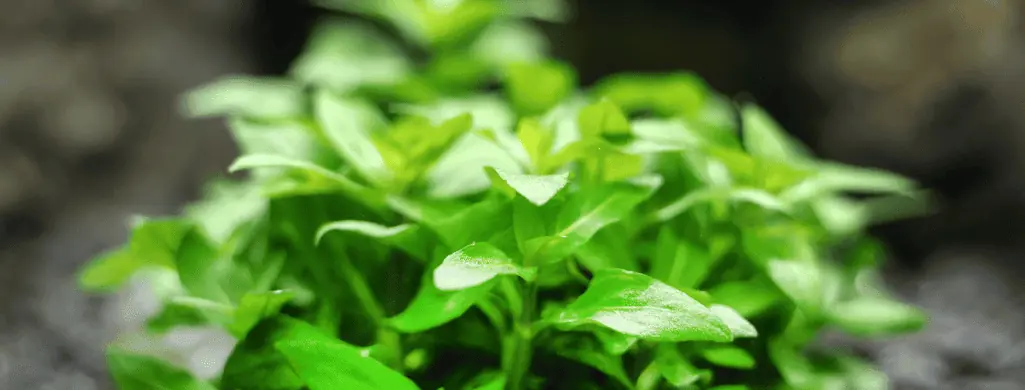
- Care: Easy
- Temperature: 68-86° degrees Fahrenheit (20-30°C)
- pH: 5.5 to 8.5
- Minimum tank size: Any
- Lighting: Low to Moderate
- Tank placement: Background, Mid-ground
Giant ambulia originates in Southeast Asia. It grows to be vibrant green and rather bushy.
Its rapid growth rate means regular pruning and trimming are necessary. Also, this plant is best suited to larger aquariums; it’s unlikely to overgrow.
Giant ambulia is a great choice for beginners, as it’s adaptive to a range of water conditions. But it sometimes needs extra nutrients to prevent its leaves from browning.
Also, for the best green color and density, ensure you offer it ideal light conditions. This plant does best in more intense lighting.
Tip: Ensure you plant your giant ambulia in fine gravel. This type of substrate allows for proper rooting.

